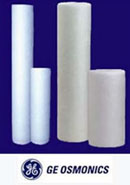About Water - Water Glossary
DEALKILATION- A process for the reduction of alkalinity in a water supply. It is generally accomplished by a chemical feed processor combined cation and anion exchange systems.
DEIONIZATION- The removal of the ionized minerals and salts (both organic and inorganic) from a solution by a two-phase ion exchange procedure. First, positively charged ions are removed by a cation exchange resin in exchange for a chemically equivalent amount of hydrogen ions. Second, negatively charged ions are removed by an anion exchange resin for a chemically equivalent amount of hydroxide ions. The hydrogen and hydroxide ions introduced in this process unite to form water molecules. The term is often used interchangeably with demineralization. The cation resin is regenerated with an acid and the anion resin is regenerated with sodium hydroxide (caustic soda).
GIARDIA LAMBLIA- A common protozoan found in water and is derived from animal droppings. It can cause contagious waterbone disease characterized by acute diarrhea. It is resistant to disinfectants such as chlorine, iodine, or ultraviolet light. Giardia can be removed by filters of four micron rating.
HARDNESS- was originally defined as a measure of the ability of water to precipitate soaps made from fatty carboxylic acids. These "soaps" precipitated in the presence of calcium and/or magnesium ions. Today, hardness is used to describe the total concentration of calcium and magnesium, expressed as mg/L of calcium carbonate.
ION- A charged particle of matter. In each system of matter, the number of positive ions (cations, such as sodium) is equal to the number of negative ions
ION EXCHANGE- Based on the principle of electroneutrality, that is, charged species are stable only when they exist as balanced pairs of positive and negative charges. Ion exchange resins, the materials used to carry out the process of ion exchange, are particles which contain fixed charges on their surface. To maintain electroneutrality, each of these charges has an ion of equal and opposite charge held to it; these ions are called counter ions.
1 2 3 4 5 6 7 8

